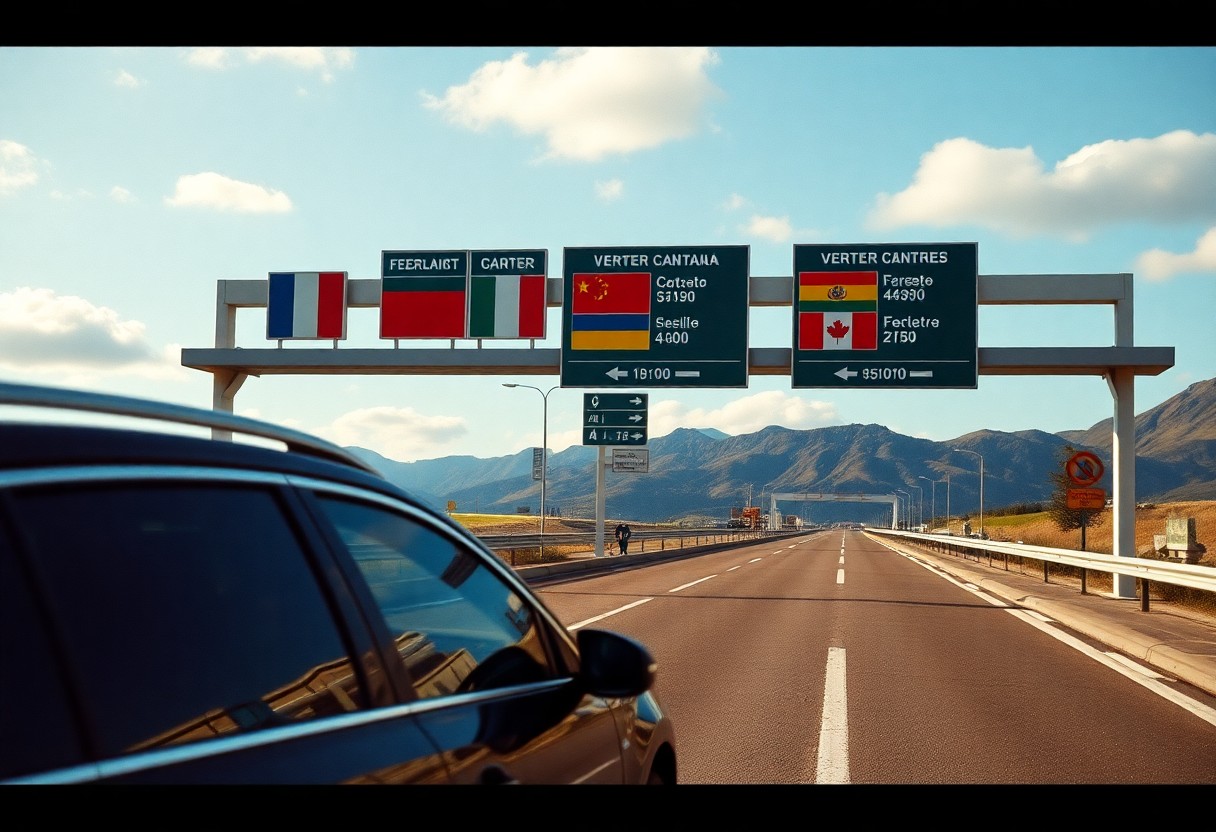When planning for an unforgettable overseas travel experience in Europe using a rental car, strategic preparation is crucial for ensuring a smooth and enjoyable adventure. This includes not only meticulously mapping out your route but also gaining a comprehensive understanding of cross-border regulations that can significantly impact your journey. Rental companies frequently have varying policies regarding travel between European countries. Generally, most agencies permit travel within Western European nations, yet there may be diverse restrictions concerning Eastern European countries. It’s essential to thoroughly review your rental agreement, as it will outline the specific borders you are allowed to cross and any potential fees that may arise. Before confirming your booking, ensure your chosen rental agency permits travel to all your intended destinations, as violating cross-border regulations could nullify your insurance and result in hefty fines. Thus, acquiring detailed information about these policies is vital for a successful European road trip.
Master the Legal Essentials for Cross-Border Driving in Europe
Before embarking on your European adventure with a rental car, fulfilling key legal and rental company requirements is paramount. Ensure that your rental agreement explicitly grants permission for cross-border travel, and importantly, confirm that you possess valid insurance coverage for every country on your itinerary. Many rental companies impose restrictions based on specific European zones, particularly for premium vehicles. Therefore, it is essential to educate yourself about these requirements to avert any problems that could mar your travel experience. Understanding the legalities involved can help you avoid potential fines or complications while exploring the breathtaking landscapes of Europe.
Secure Your International Driving Permit (IDP) Before Your European Adventure
One of the most essential documents required for driving in Europe is the International Driving Permit (IDP). Obtaining this permit is mandatory and should be arranged in your home country prior to commencing your travel plans. The IDP acts as a vital complement to your standard driver’s license and is legally required in several European countries. By securing your IDP well in advance, you ensure compliance with local driving laws and significantly enhance your driving experience across diverse nations, allowing you to focus on relishing the stunning landscapes and rich cultural experiences Europe has to offer.
Clarify Mileage Policies and Comprehend General Restrictions
Renting a car in Europe often comes with the appealing option of unlimited mileage, which is a considerable advantage for travelers eager to explore. However, it is vital to understand that border crossing fees apply, which can vary significantly, typically ranging from €5 to €47.60 for each crossing. These charges depend on your rental company and the specific countries included in your travel itinerary. Furthermore, due to insurance norms and security measures, rental agencies frequently impose unique restrictions for different vehicle categories. For example, higher-end brands such as BMW, Mercedes, and Audi usually have more limited travel zones compared to standard vehicles. Therefore, it is crucial to discuss your travel intentions with your rental agency in advance to avoid any unexpected expenses or complications that may arise.

Understand the Cross-Border Policies of Major Rental Companies
When renting a car in Europe, comprehending the unique cross-border policies of each rental company is essential for a successful journey. Major rental providers typically allow travel between Western European countries; however, strict restrictions often apply for Eastern Europe. The policies can vary significantly based on the type of vehicle you select, as luxury cars often face more limitations compared to standard models. By familiarizing yourself with these policies beforehand, you can make informed decisions regarding your rental choices and effectively plan your travel itinerary.
Explore the Cross-Border Regulations from Avis and Enterprise
Avis and Enterprise are standout rental companies that offer extensive coverage across Western Europe. Their vehicles are generally permitted for travel in most EU countries, including sought-after destinations like France, Germany, and Spain. However, it’s crucial to understand that both companies impose specific restrictions on luxury vehicles, particularly when entering Italy. For instance, Enterprise charges a daily cross-border fee of 5 euros, capping at a total of 50 euros. Being aware of these fees will assist you in budgeting effectively for your adventures across the diverse landscapes of Europe.
Review the Cross-Border Driving Policies of AutoEurope and Hertz
Among the leading rental providers, AutoEurope and Hertz enforce specific country restrictions that are vital for travelers to comprehend. For instance, taking their vehicles into Eastern European nations such as Albania, Belarus, or Ukraine is strictly prohibited. Additionally, Hertz restricts luxury vehicles and SUVs from entering Italy, while AutoEurope’s policies may differ based on their local partners. Therefore, it is essential to communicate your travel plans to your chosen provider before reserving your rental car. Your rental agreement will clarify the applicable cross-border fees, which can vary by company and destination. For example, Hertz charges 47.60 euros for crossing from Germany to another approved country, and you may require additional insurance coverage for international travel.
Be Informed About Geographical Restrictions When Traveling
The regulations governing cross-border travel with rental cars in Europe can differ widely based on the rental company and the vehicle type you select. Your rental agreement will explicitly outline which countries you are permitted to visit with your rental car. It is essential to keep your rental company informed of your intended route, as crossing borders without proper authorization can void your insurance and result in substantial penalties, potentially leading to a frustrating experience during your travels.
Identify the Countries You Are Allowed to Drive In
Most rental companies allow driving freely within Western European countries, including France, Germany, and Spain. Zone 1 countries generally encompass EU member states in Western Europe, providing the most flexibility for your rental car usage. Your rental agreement will detail all the permitted countries related to your vehicle class, ensuring you have a clear understanding of where you can travel, thus allowing you to fully embrace your European adventure.
Recognize Restricted Territories for Rental Cars
Countries behind the Iron Curtain often face stringent travel restrictions. Most rental companies prohibit travel to Eastern European nations, including Albania, Belarus, Ukraine, and Russia, due to increased risks and potential insurance complications. Additionally, further limitations may apply specifically to luxury vehicles and certain car brands. High-end vehicles like BMW, Mercedes, and other premium models frequently have stricter geographical limits. If your travel itinerary includes multiple countries, it is advisable to opt for a standard vehicle class to maximize flexibility and minimize possible fees or insurance complications.
Understand Vehicle-Specific Limitations for Rental Cars
While rental companies may adopt varying policies, most enforce strict regulations regarding which vehicles can cross borders. Hence, it is vital to verify the specific limitations associated with your selected vehicle class before making a booking. These restrictions are implemented to safeguard valuable assets and ensure compliance with insurance requirements across different European territories, thereby protecting both the rental agency and the traveler.
Enjoy Maximum Flexibility with Standard Rental Cars
Contrary to common misconceptions, standard rental cars actually provide the greatest flexibility for cross-border travel. Generally, you can drive standard vehicles in most Western European countries without requiring special permits. However, it is essential to inform your rental company about your travel intentions beforehand and be prepared to pay cross-border fees ranging from 5 to 50 euros depending on your circumstances and travel plans.
Recognize Restrictions on Luxury Vehicles for Border Crossings
Significant restrictions are in place for high-end vehicles when it comes to cross-border travel. Luxury cars face notable limitations on border crossings, with renowned brands such as BMW, Mercedes, and Audi often prohibited from entering Eastern European countries or Italy. Typically, these premium vehicles are limited to Zone 1 countries within Western Europe, which can considerably constrain your travel options.
Moreover, if you opt to rent luxury vehicles, be prepared for higher security deposits and stricter insurance requirements. Rental agencies like Sixt and Enterprise impose limitations on premium brands like Jaguar, Maserati, and Porsche, permitting them only in select Western European countries. For any border crossings, you will require special permission and possibly additional insurance coverage to ensure compliance with rental policies.
Prepare Your Budget for Border Crossing Costs
When gearing up for any cross-border trips in Europe with a rental car, maintaining a clear and realistic budget is essential. Most rental companies impose additional fees for crossing borders, even within the Schengen Area, which can significantly affect your travel finances. It’s critical to inform your rental company about your intended route and obtain written permission prior to crossing any borders to avoid unexpected financial burdens.
Typical Fees for Border Crossings to Anticipate
Border crossing fees in Europe generally range from €5 to €50, influenced by the rental company and specific situations. For instance, crossing from Germany to another allowed country may incur a fee of €47.60 with Hertz, whereas Enterprise charges €5 per day, with a maximum cap of 50 euros for trips originating in Germany. Being aware of these fees in advance will greatly assist you in better financial planning during your travels across Europe.
Consider Potential Additional Charges You May Encounter
At certain borders, you may be subject to extra insurance requirements and documentation fees. Your rental company might impose charges for special permits, particularly when traveling to Eastern European countries or when using luxury vehicles. Additionally, it’s prudent to factor in the possibility of higher insurance premiums for specific destinations, especially in Italy or Eastern Europe. Keep in mind that some credit card insurance policies may not cover all European countries, making it necessary to purchase additional coverage from your rental company to ensure peace of mind during your travels.

Master the Essentials of Ferry Travel with Your Rental Car
Not all rental companies maintain uniform policies regarding ferry travel in Europe. While most rental agencies allow ferry travel, confirming the specific rules associated with your rental is crucial to avoid complications. Crossing water borders often requires additional documentation and may incur extra fees that you should be prepared for. Furthermore, your insurance coverage might change when traveling by ferry, making it essential to grasp these aspects well in advance of your journey.
Review Company-Specific Policies on Ferry Travel
Among the notable rental companies, ferry travel policies can vary significantly. Avis and Hertz generally permit ferry travel to approved countries, but it is vital to verify destination restrictions beforehand to prevent any potential complications. Conversely, Enterprise and Sixt may require pre-authorization and additional insurance for ferry crossings, which must be distinctly outlined in your rental agreement to avoid any misunderstandings during your trip.
Important Considerations for Breakdown Coverage During Ferry Travel
Another critical factor to consider is vehicle breakdown coverage while traveling by ferry. Most rental companies hold you accountable for vehicle repatriation costs if your car breaks down after a ferry journey, which can accumulate to several thousand euros, depending on your location and the type of vehicle rented. This responsibility extends beyond mechanical failures; if you encounter an accident or the vehicle becomes unusable for any reason while on an island, you are liable for the expenses required to return the vehicle to the original rental location. Some rental companies offer additional insurance to cover these costs, but it is vital to secure this coverage before your journey to ensure comprehensive protection.
Essential Insights for Successful Cross-Border Driving with Rental Cars
When planning to drive a rental car across European borders, thorough research and understanding of the specific regulations set by your rental company are crucial for a seamless experience. While you may relish the freedom to cross borders in many European nations, each rental company has its unique set of policies and associated fees that you should be cognizant of. The type of rental vehicle you choose can greatly influence your travel flexibility, particularly with luxury cars often facing stricter limitations than standard models. Always verify the countries you can visit, account for any required border crossing fees, and check the regulations regarding ferry travel before embarking on your adventure. Diligently reading your rental agreement and securing an International Driving Permit will further prepare you for a smooth journey. Your proactive planning is key to avoiding complications at border crossings, allowing you to enjoy a more fulfilling travel experience.
Your Questions Answered: Driving Rental Cars in Europe
Can I drive my rental car to any European country?
No, rental companies impose specific regulations regarding the countries you can visit. Most companies permit travel within Western European nations such as France, Germany, and Spain. However, many enforce restrictions on travel to Eastern European nations including Albania, Belarus, and Ukraine. Luxury vehicles often come with even more stringent limitations. Always check your rental agreement for the allowed countries before any border crossings to ensure compliance.
Will I incur additional fees for crossing borders with a rental car in Europe?
Yes, many rental companies do charge border crossing fees. For example, Hertz levies 47.60 euros for each border crossing from Germany, while Enterprise charges 5 euros per day (with a maximum cap of 50 euros) for trips starting in Germany. These fees apply even when traveling within the Schengen Area. It is crucial to inform the rental company about your travel itinerary and settle these fees before crossing any borders to avoid unexpected charges.
Can I take my rental car on a ferry between European countries?
Yes, most rental companies allow ferry travel if your destination country is on their approved list. However, if your vehicle breaks down while on an island, you will be responsible for the costs associated with returning the vehicle to its original rental location. Some companies, such as Hertz, offer coverage for ferry travel through their insurance options (CDW, TP, or SuperCover). Always verify the specific ferry policies stated in your rental agreement to avoid any surprises during your travels.
The Article: Is It Allowed to Drive a Rental Car Across European Borders? appeared first on https://rentacar24.org/
The Article Driving a Rental Car Across European Borders: Is It Allowed? Was Found On https://limitsofstrategy.com
The Article Driving a Rental Car Across Borders in Europe: Guidelines First Appeared ON
: https://ad4sc.com





Comments are closed